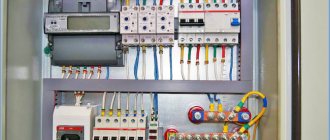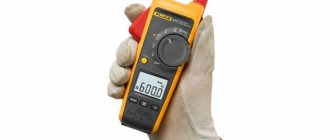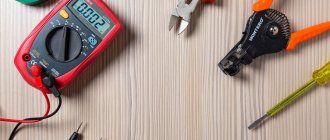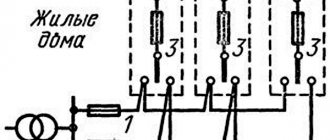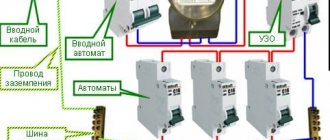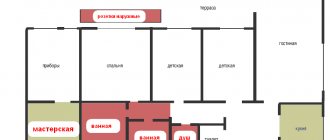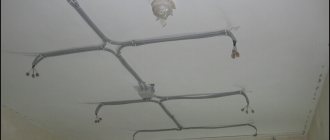When organizing electrical supply to city apartments or private country houses, an input and distribution device must be installed at their entrance. This component of the power supply system is a separate power cabinet with supply cables and switching equipment located in it. An input automatic machine (IA) is a mandatory structural element, without which it is impossible to organize a full power supply for an apartment, as well as any other residential or non-residential facility.
Design and principle of operation
Externally, the device is similar to a conventional protective device that is installed in the distribution panel.
The main difference from other means of protection is the large rated current. Elements:
- solenoid;
- bimetallic strip.
When a short circuit occurs, the current increases rapidly. A powerful magnetic field is generated in the solenoid coil, due to which the core is pulled inward and the circuit breaks.
The machines differ in the number of poles, rated current, power consumption, and phases of the power supply.
When will which machine turn off?
For convenience, I have compiled a table of the shutdown currents of the most common ratings in everyday life, characteristics “B” and “C”:
Table of short-circuit shutdown currents for AVs of different ratings and shutdown characteristics
There are two ways to use this table - based on the existing circuit breaker or based on the measured short-circuit current. For example, a C16 circuit breaker with an overcurrent of 80 A (5In) will turn off slowly and only due to thermal tripping. And at 160 A (10In) it will turn off instantly (less than 0.1 s), which is what is required during a short circuit.
And finally, let's talk about an extremely important point for everyone.
Types
The machine is selected taking into account the electrical network diagram and its needs. There are single-pole, two-pole, three-pole and four-pole devices.
Single pole
A single-pole switch is used in single-phase electrical networks. Different models have different characteristics, which determine the shutdown speed. The composition includes two release mechanisms - electromagnetic and thermal.
One is triggered when there is a short circuit, the second when the load is exceeded for a certain time. It is connected through the upper terminal, the outgoing wire is connected to the lower one. The principle of operation is the same as that of diverter machines, but the current rating is higher.
Bipolar
Used in single-phase input. The design consists of a block with two poles, which are equipped with levers and a common lock between the shutdown mechanisms. That is, the main difference from a single-pole network is that if there is a problem on any of the lines coming from it, both will be disconnected. Two-terminal networks are used in typical modern apartments.
You cannot replace one double-pole switch with two single-pole circuit breakers! This is prohibited by the PUE.
Three-pole
For three-phase networks, three-terminal and four-terminal networks are used. Such electrical networks are found in homes where food is cooked on electric stoves. To connect a three-pole circuit breaker, each terminal is connected in phase. In devices with four poles, a neutral wire is additionally used.
When installing it yourself, the ground (not the neutral) should never pass through the machine.
What other parameters are important when choosing
Number of poles
For ease of understanding, we will put three-phase switches out of brackets. We choose between 1 and 2 pole designs. From the point of view of the Electrical Installation Rules (PUE), there is no difference. But the same rules imply high-quality organization of grounding or grounding. And if a problem arises with the appearance of a phase at zero (unfortunately, this is real in old housing stock), then it would be better to completely disconnect your apartment from the power lines. Therefore, if you can choose which input circuit breaker to install, take a two-pole one.
Time - current characteristic
There are different types of time-current characteristics curves, they are designated by Latin letters: A, B, C, D... Starting from A onwards, the sensitivity of the device gradually becomes rougher. For example, type “B” means operation of the electromagnetic release at 3–4 times the current, type “C” at 5–7 times, “D” at 10 times. The thermal release will operate in the same way for different types of time-current characteristics.
More accurate data should always be obtained from the manufacturer’s documentation for each specific product, for example, for BA47-29 incoming automatic machines the response characteristics are as follows:
An example of graphs for BA47-29 with characteristics (types) B, C, D is shown below in the picture; dependencies for other types can be found on the official websites of the manufacturers. The choice of one type or another is determined by the type of load being connected, or rather its ability to consume current intermittently. For example, motors have a starting current several times higher than the rated current, and depending on their types, type “C” or “D” devices can be used. Type “B” is recommended for loads that do not have significant inrush currents.
Also, the use of types with reduced sensitivity of operation makes sense to increase the probability of operation of lower groups of circuit breakers.
Rated current
The main characteristic on which the device is mainly selected. However, as we saw in the previous section, it is also necessary to take into account the time-current characteristic, since the actual operation current depends simultaneously on both the rated current and the type of characteristic. In the previous tables, the rated current is indicated as In. Theoretically, in the absence of inrush currents, a load consuming a current equal to the rated one should not lead to operation (shutdown) of the device.
Mounting method
Today, there is no alternative. These are switches that are mounted on a DIN rail. No direct screwing to the wall or panel body. DIN mounting only. However, with the use of special accessories, other types of fastening are possible.
The device can be in a separate housing, or installed in a common panel - it doesn’t matter. The main thing is to provide free access for the owner
An important point: sealing the input machine. There are many ways to restrict access to contacts (to prevent unauthorized connections). You can install plugs on the holes for tightening the screws on the contacts. Or simply put seals on the covers covering the contact groups. The main thing is that after sealing you can easily turn on and off the power supply.
Automatic input calculation
Characteristics:
- number of poles;
- time-current characteristic;
- rated current;
- installed capacity;
- rated leakage current;
- line voltage;
- selectivity;
- maximum short circuit current.
The current rating is determined for the simultaneous connection of all electrical appliances to the network. Power also depends on current.
Powerful devices such as water heaters and electric stoves are equipped with additional input circuit breakers.
Machines for TN-S and TN-C systems are used. In the first case, a single-terminal network with a zero or a two-terminal or three-terminal network with a neutral is selected. In the second case, you need a single-pole (for a 220 V network) or a three-pole (for 380 V) circuit breaker.
Calculation for a 220 Volt apartment electrical network
Ip=Pp/(Uф*cosф). In this formula, Uph is the phase voltage, Рр is the calculated power, Ip is the load current. Cosф is a dimensionless quantity characterizing the presence of reactive power.
Calculation for a 380 Volt apartment electrical network
To calculate a switch for a 380 V power supply, the formula is slightly modified:
Ip=Pp/(Un*cosph). Un is the network voltage.
When choosing a device, the rated current should be increased by 10% for reserve.
Purpose of the introductory machine
To understand why an “input circuit breaker” is needed, let’s briefly understand what a circuit breaker is in the general case and why it is needed.
An automatic protective switch is a contact switching device that is capable of disconnecting electrical networks in the event of an emergency situation (overload or short circuit).
In appearance, operating mechanism and design, the input machine is no different from a conventional protective device that controls any electrical line. The only and most important difference is its rating, which is a certain (calculated) order of magnitude higher, taking into account selectivity, than that of any linear protective switch in an electrical panel.
An input machine must be installed when introducing an electrical cable into an apartment or private house. It protects the entire electrical network of the residential premises from overload, and also serves to turn off the power to the entire facility (for example, to carry out electrical and other repair work). It also ensures the correct operation of the supply cable and does not allow the load to be exceeded for the given room.
VA selection
In addition to the main selection criteria, there are additional ones. These include neutral mode, current frequency and line voltage.
Neutral mode
Simply put, neutral mode is the way a home is grounded. Traditionally, homes feature a TN system with various variations. The most common ones include TN-C, TN-CS and TN-S.
The TN-S system has supply neutral and working wires, which are separated from the substation to the energy consumer. The TN-C system consists of combined supply neutral and working wires.
Current frequency
One of the main parameters of the electrical network is the current frequency.
This is the number of complete cycles of change in EMF (electromotive force) in one second. For the Russian Federation this value is 50 Hz. Simply put, the current flows 50 times per second in one direction and 50 times in the other, passing through the zero value 100 times. For example, an ordinary light bulb connected to a network with a frequency of 50 Hz will flare up and go out 100 times per second.
Line voltage value
For Russian power grids, voltage is a fixed value. Equals 220 V or 380 V + - reserve. Linear is the voltage between two phases, which is 60% greater than the phase voltage. And accordingly = 380V.
Why is it unacceptable to install a circuit breaker on the neutral wire?
I corresponded via email with Volodymirom about the inadmissibility of installing a circuit breaker on the neutral wire of the electrical wiring. For those who want to understand the intricacies of this issue, I think its result will be useful.
Volodymyr: I’m currently making an electrical panel in the apartment and a question has arisen. Why can’t separate machines be set to zero and phase, but only paired ones? Why “It is strictly prohibited to install a single circuit breaker on the neutral wire.”?
Answer: When installing separate circuit breakers on the neutral and phase wires, designed for the same protection current, in the event of an overload of the electrical wiring, only one of them is likely to work. This is due to the fact that circuit breakers have a variation in the magnitude of the operating current.
If the machine installed on the neutral wire is triggered, then all electrical wiring, including the neutral wire, will be under phase voltage. The phase will reach the neutral wire through electrical appliances that are turned on at this time, for example, a TV in standby mode, a refrigerator. And if a person thinks that since the machine has worked, it means that the wires are de-energized and, therefore, safe, then he can start repairing the electrical wiring and accidentally come under dangerous voltage.
That's why it's impossible. It is possible to install twin circuit breakers in household electrical wiring, but there is no point in this, only extra costs, since a paired circuit breaker costs much more. Therefore, the neutral wire is laid directly, and a machine must be installed on the phase wire.
Volodymyr: If during a short circuit the zero-machine is knocked out faster, and the phase-man-earth short circuit continues, then the phase-machine will still be knocked out. Also, both can work approximately simultaneously. That is, the machine must be set to zero more powerful than the phase one. But there will be no disruptions to the network, only additional costs.
You can, of course, install a machine designed for a higher current on the neutral wire, but where is the guarantee that the machine will not fail? After all, the main value for any person is his health and life! Therefore, even with the hypothetical possibility of causing harm to a person, they do everything to exclude it.
Volodymyr: I’m just starting to master electrical installation in practice, including using your recommendations. And I want to understand the technical side in order to better understand the recommendations of the PUE. So forgive me if I'm wrong somewhere.
There are two common situations: 1. Short circuit phase-man-earth or phase-earth. A phase machine will work here. Zero machine has nothing to do with it.2. Short circuit phase-man-zero or phase-zero. A phase machine and/or a zero machine will work here. That is, if the phase machine does not work, then the zero one will break the circuit.
Answer: Your reasoning is based on the assumption that the machine serves to protect a person from electric shock. But the machine is designed solely to protect electrical wiring from destruction if the current flowing through it exceeds the permissible limit. To protect people, an RCD is installed.
Let me give you an example: a man decided to replace a light bulb in a chandelier and turned off only the switch, and not the machine, this is usually what they do. The wiring in the chandelier was old, and the neutral wire was touching the metal body of the chandelier. The man stood on the ground and, screwing in the light bulb, held the chandelier by the metal body with one hand.
At this time, another family member decided to turn on an electrical appliance, whose insulation at the exit from the plug had frayed and the wires were short-circuited. A short circuit occurred, and only the circuit breaker installed on the neutral wire worked, and a phase appeared on the neutral wire of the entire apartment wiring. As a result, a person changing a light bulb can receive an even fatal electric shock. The machine can also work when the lights are turned on if the light bulb burns out at that moment.
PUEs are written based on accidents involving electric shock to people and it is impossible to describe all situations in which people were injured or died. You just need to follow the PUE and then the electrical wiring will never fail.
Installation
The main type of mounting of machines is installation on a DIN rail. The devices are not screwed directly to the wall or switchboard housing.
The device can be manufactured in a separate housing or installed in a common panel. During installation, access must be provided for electricians.
The input machine must be sealed. This will protect the device from unauthorized connection. Access is limited by means of plugs on the holes.
Connection from below or from above?
The PUE states that the power cable should usually be connected to fixed contacts.
And all well-known companies have fixed ones on top. Therefore, the input machine is traditionally installed in the distribution board on the top left. For convenience, outlet lines are mounted from top to bottom. But if you mount it the other way around, all the functions will remain the same.
Connection diagram for the input machine
Fundamentally, the installation and connection of the input circuit breaker is practically no different from the installation of a conventional circuit breaker. Such a machine is mounted on a DIN rail and connected before the meter (with mandatory sealing) or after. Next, the remaining circuit breakers are installed from it to protect each line of the residential premises.
Connection diagram
The input switch is used not only for electrical safety, but also to disconnect the consumer from electricity during repair work. For this reason, the machine is installed in front of the meters.
Only a professional electrician has access to the machine. Apartment owners have no right to interfere with the security system. In 90% of cases, the machine is installed in the entrance panel in apartment buildings and in external systems (poles, fences) for cottages.
Owners can install a backup machine, which is used for ease of maintenance. It is placed between the meter and group automation inside the apartment switchboard. The current strength of the backup device should be lower than that of the input device.
What does energy sales think about this?
Let's say you have organized exemplary electrical wiring in the house, calculated each consumer to the nearest ampere, and want to get a certain current load at the input. And when you contacted power engineers, you were refused. You should know that the energy sales company is not interested in which input machine you choose. They have limits on the electrical supply line, or the nearest transformer substation. And no one has the right to exceed these standards: otherwise it will not be possible to connect the next people who want to, or the entire line will operate in constant overload mode.
Therefore, before planning the energy supply scheme for your home, visit the organization that will supply you with electricity.
Unacceptable mistakes when purchasing
The most important mistake when purchasing security devices is trying to save money without paying attention to the criteria of the machine.
An incorrectly selected circuit breaker will lead to negative consequences. It is also undesirable to buy machines from unknown manufacturers. Untested devices will not perform their duties fully, and many characteristics are often overestimated.
All major errors are related to incorrect calculation of denominations. The user may not take into account the current reserve or select the wrong line voltage - this will lead to the wrong result and, as a result, the purchase of an unsuitable machine.
Selection tips:
- When concluding a contract, the subscriber orders the required connection power. Based on this value, the installation location, load and other parameters are calculated. A spontaneous increase in load is unacceptable; the installation of a more powerful switch must be agreed upon with the relevant services.
- You need to focus on the electrical wiring. So, if household appliances can withstand a current of 30 A, and the old wire is designed for a maximum value of 10 A, you will have to replace the wiring with a more powerful one or abandon the device.
- Preference should be given to a machine with a higher current than the calculated value. For a device with 14 A, you need to take a switch of 16 A or higher.
- It is important to pay attention to selectivity. The rating of the input circuit breaker is usually 40 Amperes. For an electric stove, a 32 A switch is installed. The lighting group and sockets require 10 A.
- You should choose a powerful switch for a country house or garage. This is due to the fact that powerful welding machines, submersible pumps and other equipment that require high currents can be used.
- It is better to install automation from one manufacturer. The risk of equipment not matching each other will be minimized. Also, if a situation arises that requires repair or replacement, it will be easier for the user to contact one manufacturer.
- You need to buy devices from a specialized licensed store that has the appropriate licenses and certificates. This will minimize the risk of purchasing a counterfeit unit.
These are the basic requirements and rules for choosing circuit breakers for your home and garden. Knowing them, the buyer will not make mistakes when purchasing the desired device.
The input circuit breaker is a mandatory device for protecting the home. If an emergency occurs, the device will operate and cut off the power supply. The machines differ in the number of poles, rated current, time-current characteristic, neutral mode, mains voltage and other characteristics. Before purchasing, be sure to calculate all the parameters, otherwise electrical safety will not be ensured. When purchasing, it is important to avoid common mistakes and follow the tips given above.
How to choose a machine based on current strength
We already know that all the electrical current to power the object will flow through this switch. According to Ohm's law, it is clear that the load must be summed up based on all consumers in the house (apartment). Calculating this value is quite simple.
Tip: It is not necessary to calculate energy consumption by summing up the power of all electrical appliances.
Of course, you can turn on the boiler, electric oven, air conditioner and iron at the same time. But such a “celebration of life” will require powerful electrical wiring. And the technical conditions for such input power will cost significantly more. For energy supply organizations, tariffs for coordinating connections grow linearly depending on the number of kilowatts.
For a typical apartment, we can assume the simultaneous operation of a refrigerator, TV, computer, and air conditioner. In addition to them, it is permissible to turn on one of the powerful appliances: a boiler, an oven or an iron. That is, the total power of electrical appliances will not exceed 3 kW. We don’t take lighting into account; today, every home has energy-saving lamps.
This is interesting: if you go back 20–30 years ago, when each chandelier had only incandescent lamps, a two-room apartment with full lighting could spend 500–700 W on light alone.
Usually, for a power reserve (force majeure circumstances are possible), 20–30% is added to the calculations. If you forget to turn off the boiler and start using the iron while the air conditioner is running, you won’t have to run to the electrical panel to restore the power supply. It turns out: 4 kW divided by 220 V (according to Ohm’s law), current consumption 18 A. The nearest circuit breaker is rated 20 A.
For reference: most manufacturers of electrical products produce circuit breakers with the following operating current ratings:
2 A, 4 A, 6 A, 10 A, 16 A, 20 A, 25 A, 32 A, 40 A, 50 A, 63 A...
The marking is in the product passport, and always on the body.
When selecting a device more accurately, especially when used in conjunction with a non-standard load (motors or other loads with significant starting currents), it is necessary to make a choice not only by the rated current, but also by the time-current characteristic.
For example, the input circuit breaker shown below in the picture has a rated current of 16A and a characteristic of type “C” (type “C” is well suited for the usual standard load - our apartments).
We will tell you more about the time-current characteristic below.
We are not interested in higher currents, this exceeds the power of 15 kW. No one will approve such a connection to your apartment. Typically, residential input is limited to automatic machines with an operating window of about 32 A.
For a private home, the figures may be higher. The calculation takes into account the increased living space, the presence of outbuildings with power supply, a garage, a workshop, and powerful power tools. An input circuit breaker for supplying power to a private house usually has an operating current of 50 A or 63 A.
Why do we need automatic wiring machines?
Before you figure out which machines are better and more reliable for apartment electrical wiring, you should find out why these devices are needed at all. Reasons why it is better to purchase a machine for your apartment:
- In the event of an emergency or abnormal situation, it is easier to determine the cause, provided that protection is installed on each line.
- Lighting devices will turn off only in one room, and not throughout the entire apartment, therefore, there will be no need to look for alternative lighting sources in complete darkness. The same goes for sockets. If a problem occurs on the line where the refrigerator operates, the water heating tank will continue to operate normally.
Compared to fusible plugs and automatic plugs, automatic plugs have many advantages.
